The Ultimate Guide to Email Sequences
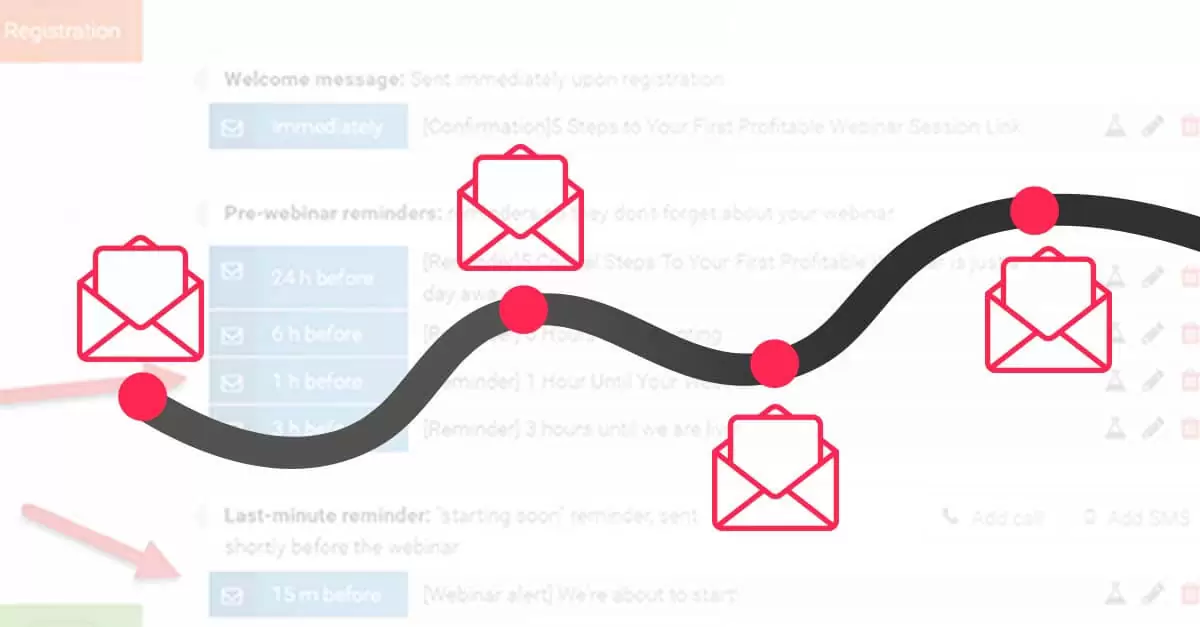
One of the first things I learnt when I started marketing online back in 2001 was how to use email sequences (right after I learnt about how to use AdWords to generate conversions).
Email marketing is one of the most powerful tactics in your digital marketing toolkit.
Why?
Because once you pay to acquire an email address (whether it’s an opt-in or a customer) you can email that person as much as you like without spending a cent more on advertising (so long as they don’t unsubscribe).
You need email marketing to generate maximum ROI from your digital marketing spend…
- The DMA’s National Client Email Report 2015 states that email marketing has an ROI of 3800%
- McKinsey reports that email is 40 times more effective at acquiring new customers than Facebook or Twitter
- MarketingSherpa found that email is the preferred source of business communication for 72 percent of consumers
Without email marketing, you’re leaving a lot of revenue on the table.
Automating email marketing with email sequences takes it to another level because you’re putting email marketing on autopilot.
In fact, in our last 3 product launches at Webprofits (where we launched various training products) we generated hundreds of thousands of dollars just by using email sequences combined with a database we had nurtured over time. And these were launches that were only open to new customers for 7 days.
We use email sequences for most of our highest paying clients at Webprofits because they generate the biggest ‘bang for buck’ – invest the time and resources upfront, and then reap the benefits of the sequence for many years thereafter.
Email sequences are one of the most under-utilized digital marketing tactics and yet one of the most powerful. In this article I’m going to share what you need to know to leverage email sequences within your digital marketing campaign.
What is an email sequence?
Just to be sure we’re all on the same page, let’s begin by defining what email sequences are and how they’re used in digital marketing campaigns.
An email sequence is a series of emails sent based on pre-set time intervals or trigger-based automations (or both).
- A time-based email sequence involves messages that are sent at predetermined intervals (e.g. immediately after opt-in, 30 days after purchase, one year after subscribing etc.). Time-based email sequences are also referred to as ‘autoresponders’.
- Trigger-based email sequences are sent whenever someone takes an action on your website or within your email sequence (e.g. not logging into the software platform for a week, clicking a link in an email, clicking links in the last three emails etc.)
You’ll start to see the real power of email sequences when you combine both types.
Why create email sequences?
I breathe, sleep and eat digital marketing but I can’t be there every moment of every day, sending targeted emails to people at the exact times they need to see them to drive action. That’s where email sequences come in.
Email sequences are automated. And when you use both timed and trigger-based emails, messages go out when they’re most likely to have an impact. For example, say I’ve got an abandoned cart email sequence set up. If an online shopper adds a product to their cart but doesn’t purchase, a triggered email series (that I only have to set up once) can follow up with that customer to return and complete the purchase, with no extra energy on my part.
Email sequences can move people through a journey of not having ever heard of your company, to becoming a customer and (potentially) an enthusiastic brand advocate. Email sequences can deepen the relationships you have with subscribers over time, solely through the content they share.
And for the record, just about every company can benefit from email sequences. Whether you’re a software company, ecommerce store or info product marketer, and whether you’re using email to build your brand, capture leads or drive sales, there’s a sequence out there that’ll help you achieve your business goals.
The different types of email sequences
Let’s break down some of the most common types of email sequences companies use. And while these may not all be applicable to you, you’ll probably need to use several of these to meet the needs of your business.
Nurture sequence
What It Is: An email message (or series of messages) designed to help introduce subscribers to your company. These messages may be used to deliver any promised opt-in bonuses (a coupon code or lead magnet, for instance) and should set subscriber expectations on the frequency and content of the messages they’ll receive in the future.
Examples:
Digital Marketer shares the following example from Daily Worth, which boasts nearly one million subscribers.
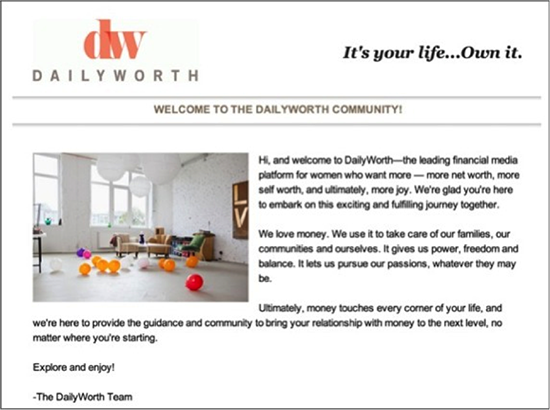
A second example from Trunk Club shows how multimedia (video, in this case) can be incorporated to help subscribers understand how the business’s unique model works:

Engagement sequence
What It Is: An engagement sequence aims to deepen the relationship with your subscriber. Once subscribers have absorbed your nurture messages, engagement sequences can help nudge them to take smaller-scale actions that’ll prime them for future conversion opportunities.
Examples:
Janet Choi of Customer.io gives two examples of messages intended to form deeper connections among subscribers (in her post, she describes this as leading them towards ‘Aha moments’).
Here, Pocket attempts to engage its most active users with messages sent annually to top 1% and 5% readers:
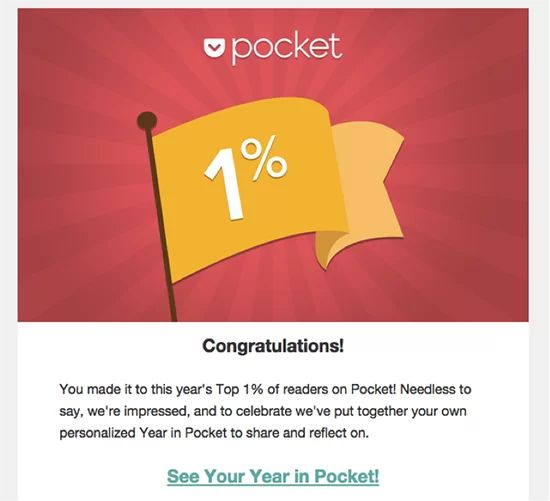
Netflix is a master of this strategy, offering personalized recommendations and easy CTAs:
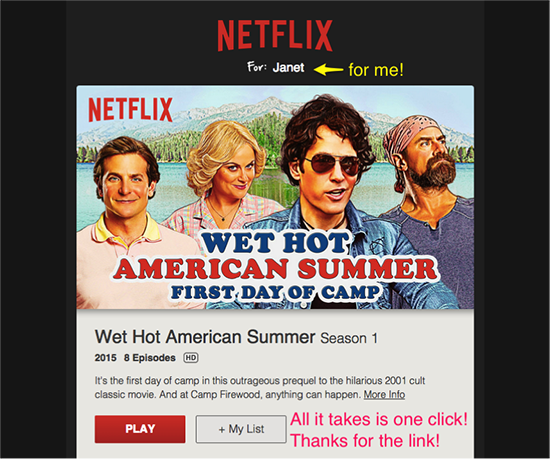
Conversion sequence
What It Is: Conversion sequences are your ‘big guns’. You’ve nurtured your subscribers and advanced your relationship with smaller-scale engagement suggestions. Now, you’re ready to ask them to take action – usually, to purchase something.
Example:
Depending on the ticket value of your conversion action, you may need one message to drive conversions or several. Take the case of Nathan Barry’s pre-launch email sequence that netted $16,000 in 72 hours for one of his app design training products.
According to Videofruit’s analysis, the sequence involved six messages, spaced out over a 12-day period:

You can see Videofruit’s full breakdown of the sequence here (including the actual content of Barry’s messages). I highly recommend checking it out – especially if you anticipate using conversion sequences to sell info products.
Onboarding sequence
What It Is: You’ve got the customer – now don’t leave them hanging! Onboarding messages ensure your new customers understand how to use the product they’ve just purchased so they can get full use and enjoyment out of it right away. People get frustrated when they can’t figure out the products they’ve purchased and you want your customers to be happy so they’ll make repeat purchases and tell others to buy.
Most often, you’ll see these sequences used by SaaS companies that need customers to be successfully using the software as quickly as possible (so that they’ll continue paying for it) but also need to incorporate a degree of workflow automation to stay profitable.
Example:
To see an onboarding sequence in action, check out Spark Page’s diagram below:
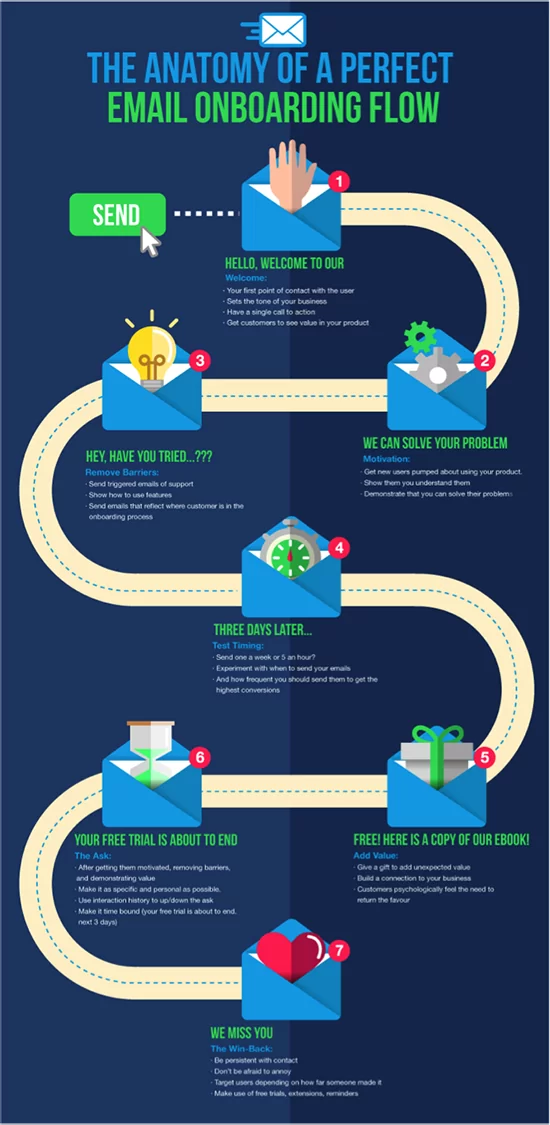
Don’t look at this infographic in terms of specifics. Use it to understand the psychology behind onboarding email sequences and substitute in key needs your own customers will have that should be addressed in post-purchase-triggered messages.
Abandoned cart recovery sequence
What It Is: A would-be buyer has left something in your shopping cart, but left without purchasing. An abandoned cart recovery sequence may help bring them back.
Examples:
Here’s a simple example from Fab, courtesy of Shopify:
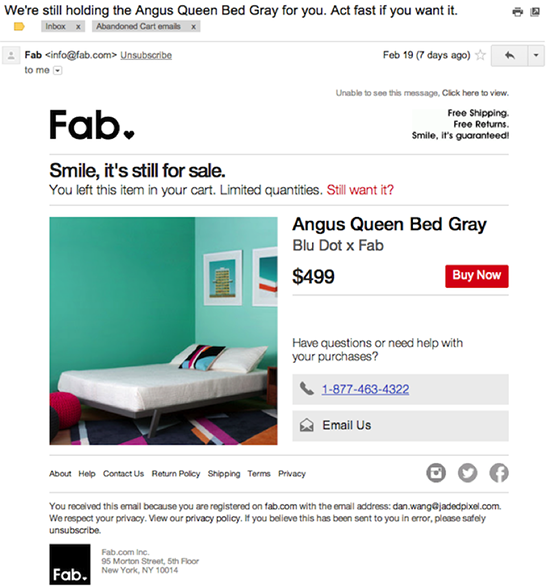
The message leverages FOMO by both emphasizing the product is still on sale and by populating the message with an appealing product shot.
According to Statista, 24% of online shoppers leave without paying because the website crashed, and 15% because the site timed out. Leveraging an abandoned cart sequence won’t just help convert those who are on the fence – it’ll help those who wanted to purchase but couldn’t for technical reasons.
Here are a few more abandoned cart emails to get you thinking:
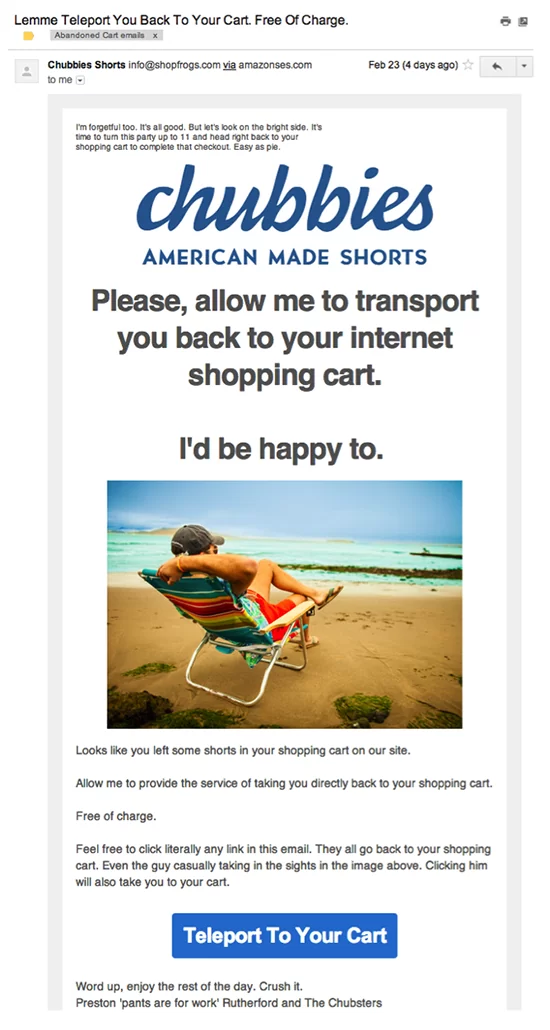
From Chubbie’s Shorts (courtesy Shopify)

From DoggyLoot (courtesy Shopify)

From HelloNomad (courtesy Shopify)
Renewal sequence
What It Is: Email list subscribers become disengaged for any number of reasons, no matter how many nurturing and engagement sequences you have in place. Maybe their inboxes are flooded or maybe they’re no longer interested in what you’re selling.
In any case, a renewal sequence (also known as a re-engagement sequence) is your ‘last ditch’ effort to bring them back into the fold. Typically, this is either one message or a sequence of 2-3 messages offering some type of reward for continued engagement.
Example:
MyEmma shares two great examples of renewal messages including this one from Boulevard Brewing Co:

And this message from Kate Spade, which served the dual purpose of re-engaging subscribers and combatting Gmail’s 2013 switch to a filtered inbox:

As a side note, renewal sequences aren’t just for re-engaging subscribers. If you’re using an email provider that bills based on the number of messages sent, regularly ‘scrubbing’ your list of subscribers that don’t engage keeps your costs down (while also minimizing the potential for negative brand sentiment).
Event sequence
What It Is: Like a conversion sequence, an event sequence aims to encourage subscriber action. In this case however, that action is attendance at an event (for instance, a live in-person meetup or an online webinar). Event sequences accomplish several things, including:
- Informing subscribers about the nature of the event and the benefits of attending
- Getting subscribers to sign up to take part (ideally, using in-message sign-ups)
- Reminding subscribers as the event approaches to ensure good attendance
- Following up after the event to share replays and get feedback
Event sequences rely on both timed messages (a number of days out from the event, for instance) and trigger-based emails (for example, people who registered to attend the event but didn’t show up).
Example:
Here’s a diagram of the webinar messaging campaign Jon Schumacher used to drive a 48% show-up rate for a sales webinar that brought in $13,420:

Follow up sequence
What It Is: Follow up sequences are similar to the onboarding sequence described above, but where onboarding messages are intended for new product users, follow up sequences should be used whenever customers complete an action (such as finishing an online course or purchasing a product).
The goals of your follow up sequence may include (among others):
- Reinforcing information learned or top-of-mind brand awareness
- Driving referral or affiliate sales
- Reiterating sales messaging (for example, extending a post-webinar sales offer)
- Sharing details on the next event
- Reminding customers to purchase a product that may have run out
Example:
The example below from SmartBug Media would be sent following a webinar with the intention of reinforcing the information learned (here, by sharing the presentation slides) and driving referrals (by requesting that the recipient share the message with others):

As you’ve probably noticed, several of these sequences would be appropriate for your email list of pre-purchase prospects, existing customers and disengaged subscribers.
What to look for in your email provider
Many of you reading this already have an email provider in place; others either don’t have one yet or don’t like the one they’re currently working with.
In any case, let’s start with the ‘must have’ features you’ll need from your provider:
The ability to segment based on what people do
It’s incredibly powerful to be able to send one message to people who have visited your webinar sign-up page and registered, and another to those who landed on the same page but didn’t convert. If you want to be able to trigger messages based on actions, you have to be able to segment those who have taken defined actions in the first place.
The ability to move users between sequences based on their specific actions
Imagine you’ve built out your email sequences so that prospects receive the following messages in the following order:
- 12 nurture emails introducing your company
- 12 engagement emails intended to deepen your relationship with subscribers
- 12 conversion emails designed to sell prospects on your software
- 12 onboarding emails designed to ensure your new customers are using your software
Now, imagine that after receiving your first engagement message, one of your subscribers goes back to your website and subscribes to your software. You don’t want that subscriber to continue in your nurture sequence because they’ll get a whole bunch of messages pitching something they already bought. Instead, you need a program that will automatically:
- Tag the user as a paying customer
- Move them out of your nurture sequence and into the onboarding sequence you designed for customers
To give you an idea of how these rules are set up in the wild, here’s an example of an automation rule from Vero that would send a message only to VIP customers who haven’t seen it before:

The ability to score leads based on their engagement
Say you sell a big-ticket item that requires the involvement of a real, live salesperson to close the deal. While you’ll still want to use email sequences to take prospects from the awareness stage to as close to converting as you can, you should also be able to use data from your email provider to figure out which prospects on your lists are close to pulling the trigger and which ones are barely warm.
This is called lead scoring, and it’s not something that every email provider offers. Take a look at the diagram below from Aritic to see why I think this feature is so important:

At every point in this email workflow where the subscriber takes an engagement action, ‘points’ are added to their lead score, according to rules defined by the sequence’s owner. In practice, the company could set a minimum threshold, where X number of points constitutes a hot lead. When subscribers reach that score, the email provider could automatically flag their record for contact by a salesperson. Cool, right?
Fully customizable templates
This should go without saying, but you need the ability to fully customize your email message templates. A great library of email templates can be nice, but I’ve found that what each individual provider offers can be very hit or miss.
If being able to work off predefined templates is important to you, review each provider’s library before subscribing (or, if possible, take advantage of the provider’s free trial to get a feel for the templates available and the ease-of-use of the editing tools). If you know you’ll be working with custom HTML, this may not be a concern.
Additionally, if there are features you know you’ll need – such as the ability to customize personalization fields in messages – double-check before signing up or shortly after. While nearly all of today’s email providers offer features like these, you’ll want to find out if something’s missing before you build out your sequences – not after.
The ability to send broadcast messages to all subscribers, subscriber segments, and subscribers not currently in a sequence
Many of your email marketing needs can be taken care of with automated sequences, but you’ll still have some left over that require the use of broadcast messages. Think of broadcasts as one-time blasts intended to reach all or part of your audience. For instance, you might use broadcasts to:
- Notify subscribers of a new article or video published on the blog
- Launch a new product or service
- Share a company announcement
- Send a message that relates to a news item and that’s too timely to be part of your evergreen email sequences
To handle these and other similar needs, you’ll want to sign up with a program that gives you the flexibility to deliver broadcast messages as needed to the customer segments you define, and that lets you send broadcasts to people who aren’t currently in a sequence to avoid disturbing their current process. These sound like simple features, yet not all email providers handle them gracefully.
The ability to API into Zapier
Zapier integration lets you integrate email with your CRM, CMS and payment systems (we use it at Webprofits to get our sales CRM, PipeDrive, to integrate with our email provider, Drip). If you can’t API into Zapier, you’ll be at a serious disadvantage.
Here’s an example of Zapier integrating Wufoo with Mailchimp:

Choosing your email marketing software provider
Choosing the right email provider is a decision you shouldn’t take lightly. Why? Because once you set up your email sequences, lead scoring and automation rules, it will be difficult to change providers. And if you do, you’ll lose a lot of the subscriber history from within that email platform.
With that in mind, here are some of the email software providers I’ve used successfully over the last few years (regardless of the size of your company or what you sell, you can definitely use one of these).
Mailchimp

Website: https://mailchimp.com/
Pricing: Paid plans starting at $10/month
MailChimp does offer a free plan, but as the free plan doesn’t allow the creation of automated email sequences, it’s pretty much irrelevant to this article.
Overall, the program’s paid plans are both simple and effective – until you start getting into some of its more advanced features. The system doesn’t segment easily, and you won’t be able to exclude people already in a sequence from broadcast emails. MailChimp does have a pretty robust support resource library, but expect some extra hunting around if you plan to use everything the system offers.
Drip

Website: https://www.drip.co/
Pricing: Free up to 100 subscribers; paid plans begin at $41/month
Drip is one of the best email providers out there, in my opinion, because it’s incredibly easy to use, it has all the features I need, and it isn’t too expensive for what it does. It’s owned by Leadpages, so there’s a nice integration there if you use a lot of landing pages, and it also integrates with Pipedrive (the sales CRM we use at Webprofits) via Zapier.
Vero

Website: https://www.getvero.com/
Pricing: Starter plan begins at $99/month for up to 12,500 customers
Vero is awesome, especially if you’re a product-based entrepreneur who anticipates using a lot of event triggers in your email sequences. The biggest downside, however, is that you’re going to need a developer to integrate it into your CRM. That’s less of a problem if you have a developer on your team; it’s another cost to add if you don’t.
Infusionsoft

Website: https://www.infusionsoft.com/
Pricing: Packages begin at $199/month for up to 2,500 contacts
Mailchimp, Drip and Vero are email-only solutions; Infusionsoft is a complete suite encompassing email marketing automation and a full CRM system. No matter what industry you’re in, it’s probably got all the features you need, but know that all those options can make this one tricky to set up. It’s a huge application that can take a long time to figure out. Its onboarding support is generally good, but I’ve spent hours digging around, trying to find features that are made much more obvious in other programs.
Intercom

Website: https://www.intercom.com/
Pricing: Paid plans as low as $49/month for early-stage companies; $110/month for all others
Intercom is more than email automation – its platform also encompasses a live chat feature, knowledgebase tool and help desk system. If you’re involved with software, Intercom is one of the best tools on the market, thanks to its ability to send automated emails and in-app messages based on the way users interact with your program.
As a note, the programs I’ve listed here are able to cover all the email sequence types described above with the exception of one: your abandoned cart recovery sequences. For those, you’ll need to work with the tools made available by your shopping cart (although, ideally, your solution should also include all the features outlined above so it doesn’t overlap).
Here’s how some of the biggest ecommerce shopping carts handle abandoned cart recovery:
- Shopify: https://help.shopify.com/manual/orders/abandoned-checkouts
- WooCommerce: https://docs.woocommerce.com/document/automated-follow-up-emails-docs/cart-abandonment-emails/
- Squarespace: https://support.squarespace.com/hc/en-us/articles/207294117-Abandoned-Checkout-Recovery
- Magento: https://www.youtube.com/watch?v=1Z7hnour6us
What should your emails look like
No matter which email provider you choose, you’ll likely find a library of templates at your disposal to use in your messages. Use caution, however, when selecting your design, as there are certain standards and expectations you’ll want to meet, depending on the industry you’re in.
If you’re in ecommerce for instance, your messages need to:
- Be highly designed
- Match the look and feel of your website
- Show off your product effectively
Here’s an example from Lomography that hits all these points:

Image Source: Mailbakery
On the other hand, if you’re a software company or service provider, you’ll likely do better with messages that seem as if they’re coming directly from a person at your business (even though they’re actually part of your automated sequences) as in the following example:

Image Source: Hubspot
A couple notes on email design:
- If you’re an ecommerce seller and you don’t have a designer on your team who can handle creating the kind of message pictured above, hire it out. Don’t skimp – spend the money to create the type of emails your customers are expecting to receive.
- Not sure what type of emails you should be sending? Subscribe to a few of your competitors’ lists and watch how they handle their email sequences.
- Don’t forget to test. The recommendations I made above are broad. You may find that your ecommerce subscribers respond best to plain-text messages, or that your software customers like seeing highly-designed emails. You won’t know for sure until you test your approach.
How to write a great email sequence
You’ve got your email provider. You know what different types of email sequences look like. You even know what your messages should look like. Now what on earth do you put in all those messages you’re supposed to be sending?
Writing emails – just like writing any other type of web copy – is something that’s part art, part science. Yes, you need to be creative and engaging. However, you also need to follow a set of guidelines marketers have discovered over the years to ensure that the content of your messages connects with the people reading them.
Use evergreen content
An email sequence is something you want to be able to set up once and run forever (or for a very long time, at least).
So, imagine that you get the idea to put a message like, ‘The Top 10 Spring Style Trends for 2017’ into a nurturing or engagement sequence. If you run a clothing or accessory company, that kind of information could be incredibly useful for your subscribers… for now.
Eventually, the message is going to ‘expire’. If you don’t remove it from your sequence, it’s going to be delivered to subscribers during different seasons and different years – and your readers are going to notice.
Instead, focus on creating content that isn’t tied to a particular time or a recent news story. If you need to do something timely, send it in a broadcast. With email sequences, stick to time-agnostic, evergreen messages to save yourself the headache of jumping in and out of sequences to remove outdated emails.
Personalize whenever possible
Data from Experian suggests that personalized emails deliver 6x higher conversion rates, even though 70% of companies fail to use them.
Nearly all email providers offer personalization features, though the extent of the fields you’ll be able to customize depends on your platform and the types of data you’ve collected from your subscribers. The following are a few of the shortcodes used by Drip to personalize its messages:

As mentioned in the image, shortcodes like these can be inserted into email message templates to pull information from the recipient’s record. While the template might read “{{ subscriber.email }}”, the message, when sent, would read the subscriber’s actual email address.
Beyond inserting the recipient’s first name into the message, these personalized shortcodes can be used in much more robust ways. Using Drip, for example, you can:
- Use personalization tags to add urgency by setting ‘deadlines’ for specific actions with custom date filters (even if no hard deadline actually exists)

- Customize your CTAs based on customer tags
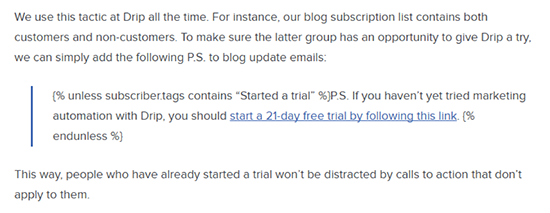
- Tailor your message’s focus to different groups with customer tags

A word of caution on personalization… don’t let your emails read like they’re coming from a used car salesman. We’ve all opened up messages that start out “Dear FIRST NAME” or “Hi Johnny – Johnny, can I ask you a question?” Think of personalization as more of a strategic opportunity than simple customizations.
Plan your sequence goals before creating content
Two things to note when creating email sequences:
- The type of content you should create will be different based on what you’re selling and who you’re trying to reach
- The length and structure of your email sequences will vary based on these same factors
What that means, in practice, is that you need to understand what specific outcomes you’re trying to achieve and what your industry’s best practices are for achieving them.
If you sell software, for example, you may wind up sending significantly more onboarding or follow-up sequences than an ecommerce store, that might focus more on engagement messages (especially those sending coupon codes or product announcements) and abandoned cart recovery sequences.
If you’re trying to capture leads or build brand awareness, your nurturing and engagement sequences may be very short – you may not even need a conversion sequence. On the other hand, if you’re selling an expensive info product, you’ll likely want to invest much more in crafting an exceptional conversion sequence.
The bottom line on email creation is this: test, test and test some more.
Watch the opens and clicks each message in your sequence gets, and see where subscribers are getting stuck. Digital Marketer has an email marketing training program called ‘The Machine’ that’ll help you figure out how to handle leaky email sequences or subscribers who fail to progress, but it really all comes down to testing and tracking.
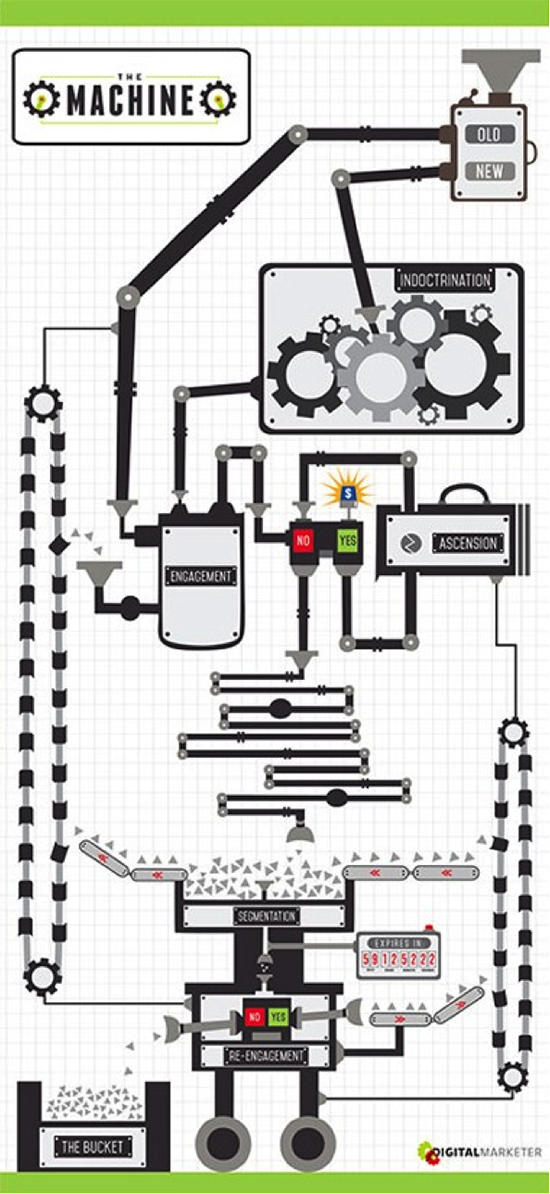
Be laser-focused on finding out what works for your subscribers and ruthless about cutting out anything that doesn’t move them forward.
Taking your email sequences to the next level
If you’re starting from scratch, use the instructions above to put at least one of the email sequences described here into place.
If, on the other hand, you’re comfortable with basic email sequence automation and ready to take your messaging to the next level, consider the following suggestions:
Combine multiple sequences
In an ideal world, your subscribers won’t just enter a single email sequence (or even a string of multiple sequences structured sequentially) and then exit. Instead, they’ll be woven seamlessly through multiple sequences in order to both deepen and broaden their engagement with your brand.
As an example, suppose you’ve followed Brian Dean’s advice and created multiple ‘content upgrade’ lead magnets to drive email opt-ins. You might build an email sequence for audience members who request one of your upgrades that includes nurturing, engagement and maybe even conversion messages.
Once your subscriber has run through this series, you don’t want to leave them inactive. Instead, why not trigger a message introducing them to another one of your content upgrades? They’ll get helpful information for free (thanks in part to the new email sequence they’ll be added to if they accept your offer) and you’ll get a subscriber who continues to be engaged by your brand.
Creating systems like these requires multiple sequences to be running side-by-side, as well as a complex system of rules that moves subscribers between sequences as needed, based on tags and other triggers.
Here’s a (barely legible, I know) look at how multiple sequences could operate simultaneously, courtesy of Gen Y Medium:
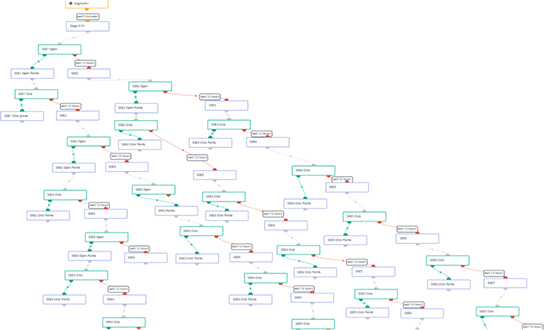
My advice to you is this: if you want to create multiple email sequences, start slow. Create a core sequence, then add separate series individually so that you can test for triggering errors before adding even more to the mix.
Combine website and email usage
This is another fun one that’s especially relevant to the work I’m doing with Webprofits right now.
Earlier in this article, I talked about how important lead scoring can be when you’re working with big-ticket, long-sales-cycle products or services (like our agency’s marketing contracts). And while scoring activities within email sequences helps us better understand when certain prospects are about to convert, we can make our scoring capabilities even more powerful by adding website usage into the mix.
Imagine that, in addition to knowing which prospects opened specific emails, we could also determine which pages they visited on our website and set scoring rules based on all these engagements together.
For example, we could trigger an event whenever a prospect visited a page where we promoted a case study, moving them from a nurture sequence to a conversion sequence.
Depending on the complexity of the systems you’re hoping to implement, you may also need a developer to make the necessary integrations with your CRM or help you place your tracking cookies.
Integrating sequences with a sales team
Finally, to really amp up the power of your email sequences, bring a sales team into the process.
For instance, at Webprofits, we use the Pipedrive CRM with the Drip email provider. What we’re able to do, thanks to Zapier, is start and stop email sequences based on the way our sales people move prospects back and forth between Pipedrive stages.
If they have a call with a prospect and move them to a ‘proposal’ stage, we can start an email sequence designed to support them through this process. If, on the other hand, they are moved to the ‘lost’ stage, we can start an email sequence designed to stay in touch with them over the next year and bring them back in when their contract might expire.
Basically, with this type of integration, marketing and sales can work together – each doing what they do best. Marketing can plan campaigns, execute them within the email provider’s platform and measure the results of different sequences. Sales can then take over the best leads, ultimately doing more for your conversion rates than any number of messages you can write.
We’ve covered a lot of ground here, and if you’re new to email sequences, start with a nurture sequence and then build on it from there. And if there are any questions I can answer, leave me a note in the comments below, and I’ll do my best to help.





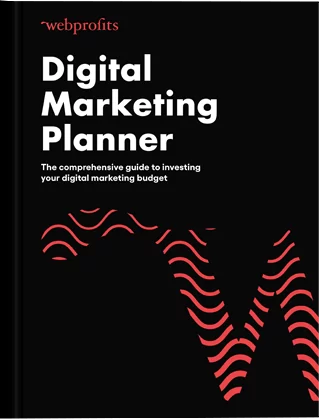
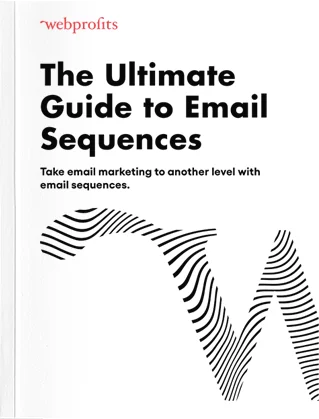
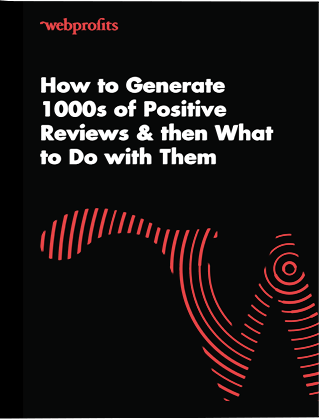
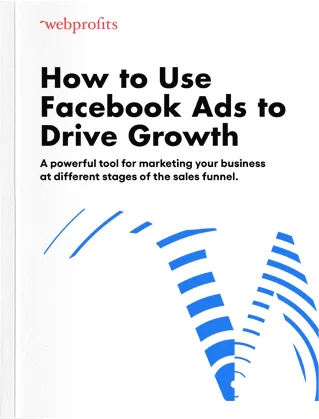
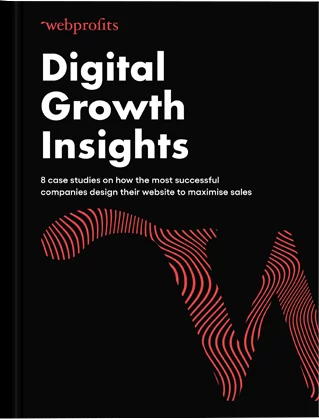
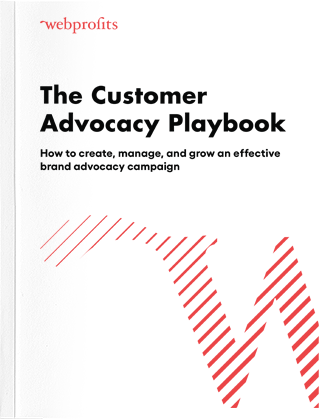
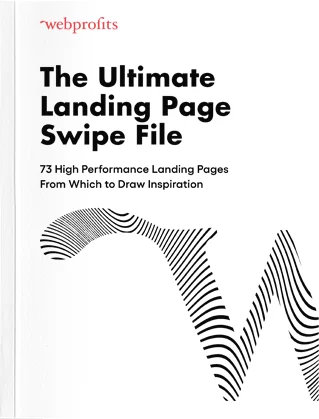

[…] also added a product to the shopping cart but I didn’t receive any abandoned cart recovery emails (note: they use Klaviyo, which can handle all of the above emails PLUS abandoned cart recovery, […]
[…] if you hire out the creation of the messages that populate your email sequences, expect to pay between $50-$400+ per email; this isn’t strictly necessary, as you can write them […]
[…] series with messages that are tailored to the specific funnel stages your ads are tied to. Our Ultimate Guide to Email Sequences gives a great overview on how to do this […]
Thanks!.. I learned a lot…
I would like to thank you for posting a nice blog and it is really great information with us which is related to business websites.
That’s a good point that you would be able to advertise to a person for free if you have their email address. I would think that if you had them set up an account with their email t use your product or service then you could get it that way. I’ll have to think about giving that a try if I decide to start a business.
Thank you for the great article. I like the bit about personification and achieving higher conversions.
I read your blog it’s very informative for email-sequences.Thanks for the sharing.